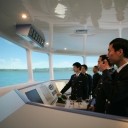Freak Wave
The world's oceans claim on average one ship a week, often in mysterious circumstances. With little evidence to go on, investigators usually point at human error or poor maintenance but an alarming series of disappearances and near-sinkings, including world-class vessels with unblemished track records, has prompted the search for a more sinister cause and renewed belief in a maritime myth: the wall of water. Waves the height of an office block. Waves twice as large as any that ships are designed to ride over.
These are not tsunamis or tidal waves, but huge breaking walls of water that come out of the blue. Suspicions these were fact not fiction were roused in 1978, by the cargo ship München. She was a state-of-the-art cargo ship. The December storms predicted when she set out to cross the Atlantic did not concern her German crew. The voyage was perfectly routine until at 3am on 12 December she sent out a garbled mayday message from the mid-Atlantic. Rescue attempts began immediately with over a hundred ships combing the ocean.
The ship was never found. She went down with all 27 hands. An exhaustive search found just a few bits of wreckage, including an unlaunched lifeboat that bore a vital clue. It had been stowed 20m above the water line yet one of its attachment pins had twisted as though hit by an extreme force. The Maritime Court concluded that bad weather had caused an unusual event. Other seafarers could not help but consider the possibility of a mythical freak wave.
Freak waves are the stuff of legend. They aren't just rare, according to traditional views of the sea, they shouldn't exist at all. Oceanographers and meteorologists have long used a mathematical system called the linear model to predict wave height. This assumes that waves vary in a regular way around the average (so-called 'significant') wave height. In a storm sea with a significant wave height of 12m, the model suggests there will hardly ever be a wave higher than 15m. One of 30m could indeed happen - but only once in ten thousand years.
Except they do happen with startling frequency. Since 1990, 20 vessels have been struck by waves off the South African coast that defy the linear model's predictions. And on New Year's Day, 1995 a wave of 26m was measured hitting the Draupner oil rig in the North Sea off Norway. Concerned shipping operators wanted to know what was going on. The largest wave marine architects are required to accommodate in the design strength calculations is 15m from trough to crest. If that assumption were to be proved false, the whole world shipping industry would face some very tough choices.
What could cause such extreme waves? Curious about the spate of South African incidents, oceanographer Marten Grundlingh plotted the strikes on thermal sea su***ce maps. All the ships had been at the edge of the Agulhas Current, the meeting point of two opposing flows mixing warm Indian Ocean water with a colder Atlantic flow. Radar surveillance by satellite confirmed that wave height at the edge of this current could grow well beyond the linear model's predictions, especially if the wind direction opposed the current flow.
Problem solved: the answer was just to avoid certain ocean currents in certain weather conditions. There was nothing freakish about large waves; the mariners' myth was an explicable phenomenon. To science, this was one that didn't get away.
Unfortunately, ocean currents could not explain two near disastrous wave strikes in March 2001. Once more two reputable ships, designed to cope with the very worst conditions any ocean could throw at them, were crippled to the point of sinking. The Bremen and Caledonian Star were carrying hundreds of tourists across the South Atlantic. At 5am on 2 March the Caledonian Star's First Officer saw a 30m wave bearing down on them.
It smashed over the ship, flooding the bridge and destroying much of the navigation and communication equipment. The Caledonian Star limped back to port, her crew and passengers grateful that the engines had kept running, despite the onslaught.
Just days earlier, the cruise liner Bremen had been less fortunate. 137 German tourists were aboard when she too faced an awesome wall of water in the South Atlantic. The impact knocked out all the instrumentation and all power, leaving them helpless in the tumultuous sea. Unable to maintain her course into the waves, there was a real risk the ship could go down and they knew none of the passengers would survive in lifeboats in such freezing conditions. With emergency power only, the crew battled to restart the engines. When they eventually succeeded, it opened the door to a very lucky escape.
No current could have created such huge waves. There is none in that part of the Atlantic. Clearly, there was another effect investigators needed to find. Except someone already had: it existed (on paper at least) in the world of quantum physics. Al Osborne is a wave mathematician with 30 years experience devising equations to describe open ocean wave patterns. Quantum physics has at its heart a concept called the Schrodinger Equation, a way of expressing the probability of something happening that is far more complex than the *** linear model. Al's theory is based on the notion that in certain unstable conditions, waves can steal energy from their neighbours. Adjacent waves shrink while the one at the focus can grow to an enormous size. His modified Schrodinger Equation had been rejected in the past as implausible, but with research attention centred on analysing these rogue waves - including global satellite radar surveillance by the new European Remote Sensing Satellite - data began to emerge backing his case. When Al came across the New Year's Day 1985 wave profiles from the Draupner oil rig, he saw his mathematical model played out in the real world.
Al's work - if correct - suggests that there are two kinds of waves out on the high seas; the classical undulating type described by the linear model and an unstable non-linear monster - a wave that at any time can start ***ing up energy from waves around it to become a towering freak. The consequences for ship design could be stark.
Currently the biggest wave factored into most ship design is smooth, undulating and 15m high. A freak wave is not only far bigger, it is so steep it is almost breaking. This near-vertical wall of water is almost impossible to ride over - the wave just breaks over the ship. According to accident investigator, Rod Rainey, such a wave would exert a pressure of 100 tonnes per square metre on a ship, far greater than the 15 tonnes that ships are designed to withstand without damage. It's no wonder that even ships the size of the huge freighter München can sink without trace.
请登录后发帖


 联系我们人工客服
联系我们人工客服



















 :1391995811
:1391995811

